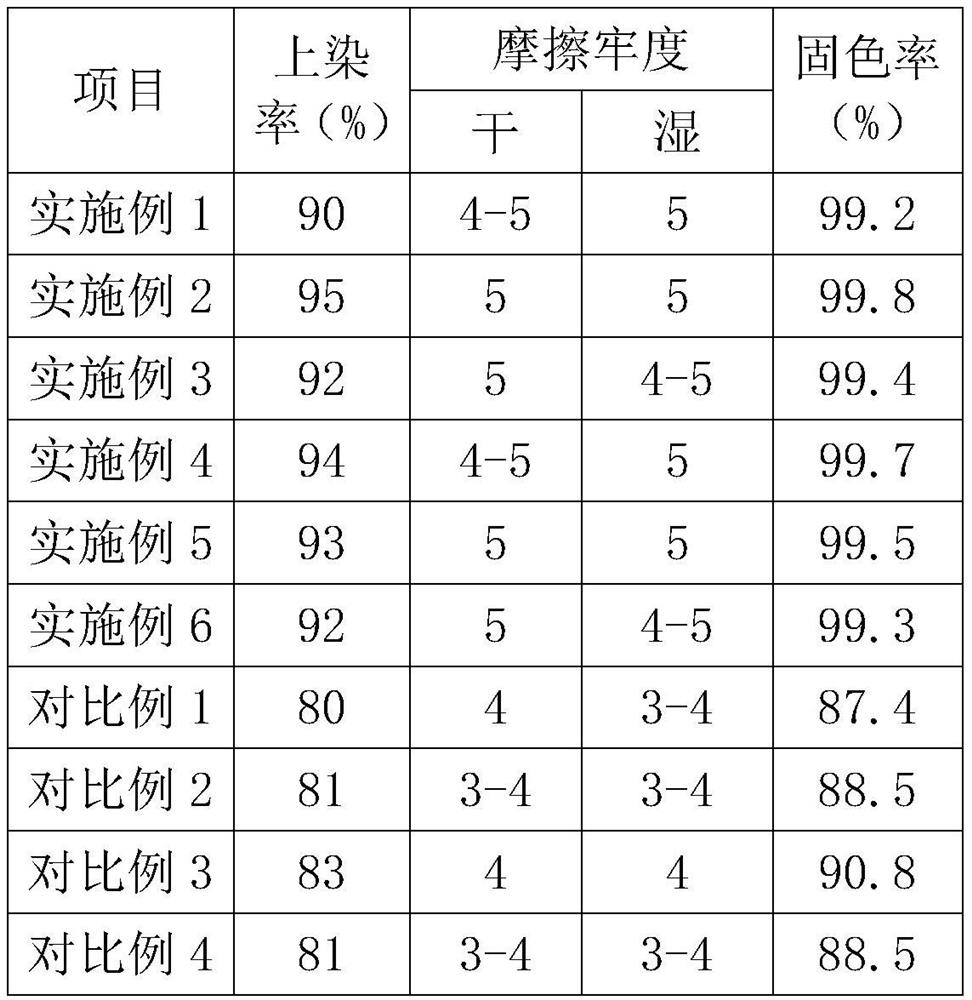Cotton knitted fabric printing and dyeing process
A printing and dyeing process, cotton knitting technology, applied in the field of textile printing and dyeing, can solve the problems of insufficient dyeing rate and fixation rate, and achieve the effects of improving dyeing rate and fixation rate, improving printing and dyeing effect, increasing level dyeing and penetration dyeing Effect
- Summary
- Abstract
- Description
- Claims
- Application Information
AI Technical Summary
Problems solved by technology
Method used
Image
Examples
Embodiment 1
[0037] A cotton knitted fabric printing and dyeing process, comprising the following steps:
[0038] S1: The pretreatment stage includes activation treatment and cationic reagent modification;
[0039] S11: activation treatment,
[0040] 1) Use sodium hydroxide to prepare an activation solution with a concentration of 0.2 / mL;
[0041] 2) Immerse the fabric in the activation solution, and soak it for 1 hour under stirring; then, use hydrochloric acid solution to adjust the pH of the activation solution to 0.65; after that, take the fabric out, roll it dry, and dry it at 80°C for 5 minutes, Obtain activated cotton fiber fabric.
[0042] S12: Cationic reagent modification, including primary modification and secondary modification;
[0043] 1. One-time modification, preparation concentration is the betaine solution of 2wt%, and adds sodium hypophosphite monohydrate, makes cationic modification liquid 1, and the weight ratio of sodium hypophosphite monohydrate and betaine is 4: ...
Embodiment 2
[0053] A cotton knitted fabric printing and dyeing process, comprising the following steps:
[0054] S1: The pretreatment stage includes activation treatment and cationic reagent modification;
[0055] S11: activation treatment,
[0056] 1) Use sodium hydroxide to prepare an activation solution with a concentration of 0.25 / mL;
[0057] 2) Immerse the fabric in the activation solution and soak it for 1.5 hours under stirring; then, adjust the pH of the activation solution to 0.7 with hydrochloric acid solution; after that, take out the fabric, roll it dry, and dry it at 80°C for 5 minutes , to obtain activated cotton fiber fabric.
[0058] S12: Cationic reagent modification, including primary modification and secondary modification;
[0059] 1. primary modification, preparation concentration is the betaine solution of 5wt%, and adds dicyandiamide, makes cationic modification liquid 1, and the weight ratio of dicyandiamide and betaine is 4.5: 100; Then, the obtained in step S...
Embodiment 3
[0069] A cotton knitted fabric printing and dyeing process, comprising the following steps:
[0070] S1: The pretreatment stage includes activation treatment and cationic reagent modification;
[0071] S11: activation treatment,
[0072] 1) Use sodium hydroxide to prepare an activation solution with a concentration of 0.3 / mL;
[0073] 2) Immerse the fabric in the activation solution and soak for 2 hours under stirring; then, adjust the pH of the activation solution to 0.75 with hydrochloric acid solution; after that, take the fabric out, roll it dry, and dry it at 80°C for 5 minutes, Obtain activated cotton fiber fabric.
[0074] S12: Cationic reagent modification, including primary modification and secondary modification;
[0075] 1. primary modification, preparation concentration is the betaine solution of 8wt%, and adds sodium hypophosphite monohydrate, makes cationic modification liquid 1, and the weight ratio of sodium hypophosphite monohydrate and betaine is 5: 100; T...
PUM
 Login to View More
Login to View More Abstract
Description
Claims
Application Information
 Login to View More
Login to View More - R&D
- Intellectual Property
- Life Sciences
- Materials
- Tech Scout
- Unparalleled Data Quality
- Higher Quality Content
- 60% Fewer Hallucinations
Browse by: Latest US Patents, China's latest patents, Technical Efficacy Thesaurus, Application Domain, Technology Topic, Popular Technical Reports.
© 2025 PatSnap. All rights reserved.Legal|Privacy policy|Modern Slavery Act Transparency Statement|Sitemap|About US| Contact US: help@patsnap.com

